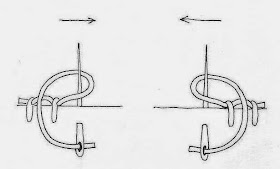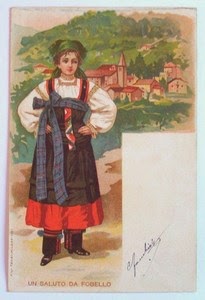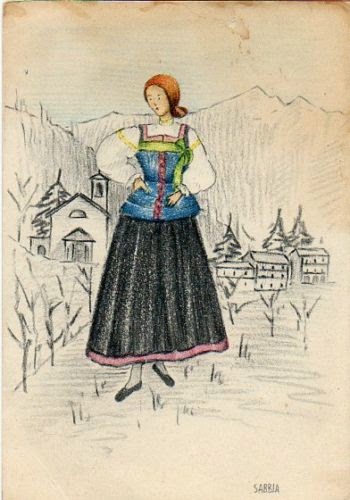Hello all,
Valsesia is the valley of the Sesia river. It is found in the north of the Italian Paese of Piedmont, east of Valle Aosta, and forms the northern lobe of the province of Vercelli. Here is a map of the general area.
All of the variants are based on a chemise, traditionally of linen, sometimes today of cotton. The sleeves are attached at at right angle to the body, as is traditional in most places.
This type of openwork is called Puncetto [poon-chet-toe], and is indigenous to Valsesia. The only tools used are needle and thread. It is worked in journeys back and forth to the right and then to the left. Knots are made, and some portions are left open, and thus the pattern is built up. The knots to the right are mirror images of the knots going to the left. Here is a photo of the technique.
A bodice with an attached skirt is worn over the chemise. They are black, and there is a panel of red cloth attached to the hem, which varies in width from village to village. Here is E. Calderini's image of the Fobello costume. The hem length varies according to time period and taste.
Here is her drawing of the bodice, showing the ornamentation of the back. The neck and arm openings are bound with red, and there are many-colored silk pompoms attached to the back at the ends of applied ribbon.

The apron is similar over all of the Mastallone valley. The Walser inhabitants of the village of Rimella tie it around the waist, but the rest of the valley's inhabitants tie it under the armpits, as in Calderini's image above. Here is her image of the costume of Rimella.
For more on the Walser, see this article.
http://en.wikipedia.org/wiki/Walser
Set into the middle of the apron is a wide panel of the same sort of puncetto as is used on the chemises, except this is done in the same colors as the embroidery on the apron. This colored puncetto is only native to Val Mastallone, but has since spread.
This panel only reaches to the waist, as you can see here. Another panel is set into the bottom of the apron, with the middle left blank. Since the apron is always worn folded up, the blank part is not visible when worn. A narrow band of floral embroidery flank these central panels of puncetto in matching colors.
Slippers of wool with a colored bound edge and quilted soles are worn with this costume, while traditionally black, they are now made and sold in many colors.
For more formal occasions such as weddings and baptisms a short red jacket is worn, along with a richly decorated plastron which is tucked into the opening of the bodice, and has the top edge showing above the sash.
And this is the costume of Val Mastallone.
Here are some images which I have been able to assign to a particular village. There was evidently variation in the past.
Fobello
Cervatto
Cravagliana
Sabbia
Just a couple more images of this costume.

Here is a video showing displays in the village museum of Fobello.
https://www.youtube.com/watch?v=Z_0YzgNoC6Q
For those who are interested in puncetto, there are good sources online in Italian,
https://www.youtube.com/watch?v=XweZDJ7vKc4
German
https://www.youtube.com/watch?v=XcNNhAELstg&list=PLRzJzdncOnWqpiIiCD2uXwAjBDfiKW-gh
and even Slovak
http://sitakrajka.blogspot.com/2012/03/puncetto-valsesiano-1-plne-prazdne.html
but little in English.
http://lacenews.net/2010/09/06/on-the-internet-puncetto-valsesiano/
Roman K
email:
rkozakand@aol.com
Source Material:
Emma Calderini, 'Il Costume Popolare in Italia', Milan, 1934
Carla Rossetti et al, 'A Scuola di Puncetto Valsesiano', Varallo, Italy, 2009
Paola Scarrone et al, 'Manuale del Puncetto Colorato', Varallo, Italy, 2006
http://www.valsesia.it/tradizione/costumi.htm


































































Great Post :) i like your site
ReplyDeleteWonderful site. Is Brescia located in one of the areas you cover? I could not find it on the crowded maps.
ReplyDeleteThank you.
Hello, and thank you.
DeleteNo, i have not covered Brescia as of yet.
Brescia is in eastern Lombardy.
If you look at the map above, you will see Brescia at the right edge of the map.
I may get to that area in the future.
Im glad you enjoyed it.
Thank you for your work preserving these traditional costume techniques and making them available to others. There is a richness in them that inspires and brings people together across generations and cultures. This is my first visit to your site. Bless you. Liz from northwest Illinois. Merry Christmas and Happy Holidays!
ReplyDeleteHow interesting, I have come to your blog via a link from 'Needle and Thread'.
ReplyDeleteThank you
DeleteYes, please post more on puncetto when you have the chance. I took it for filet crochet at first. Very pretty effect.
ReplyDeleteBeautiful folk costume
Thank you for a very informative and well researched post. I have stumbled upon puncetto on the web a couple of years ago and have been hooked ever since, having produced quite a few nice pieces. It is fascinating what one can do with just a needle and a thread.
ReplyDeleteLooking forward to more posts
Merry Christmas
Chris
Thanks a lot for the info about ' puncetto' alongwith photos.
ReplyDeleteI would like to know where 'puncetto' cleasses will be held in paris?
I realize this is a very old thread now, wonderful, thank you. I am very interested in historic costume, pity it has become so rare now. I suppose these valleys were very isolated in the past. I believe there were some very isolated valleys a bit further South, a group called the Waldensians, from France(?) settled there
ReplyDeleteGreat blog!
ReplyDeleteWonderful folk embroidery!
ReplyDelete